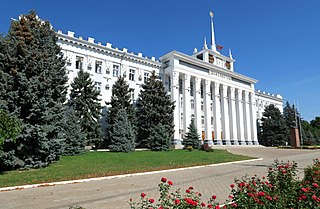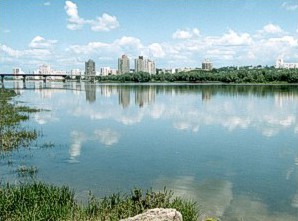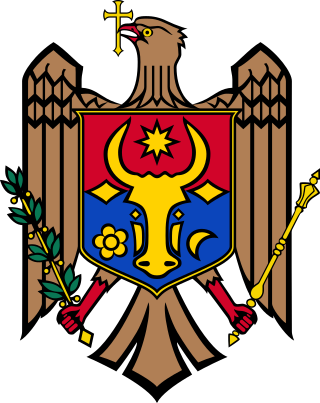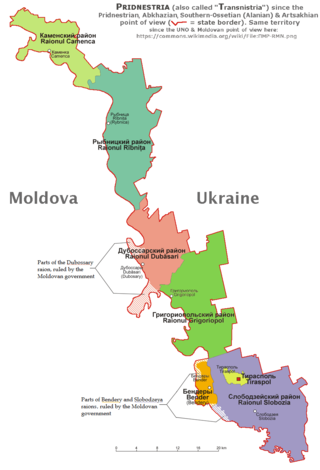
Tiraspol is the capital and largest city of Transnistria, a breakaway state of Moldova, where it is the third largest city. The city is located on the eastern bank of the Dniester River. Tiraspol is a regional hub of culture, economy, tourism, and light industry, such as furniture and electrical goods production.

Transnistria, officially known as the Pridnestrovian Moldavian Republic (PMR), is a breakaway state internationally recognized as part of Moldova. Transnistria controls most of the narrow strip of land between the Dniester river and the Moldova–Ukraine border, as well as some land on the other side of the river's bank. Its capital and largest city is Tiraspol. Transnistria is officially designated by the Republic of Moldova as the Administrative-Territorial Units of the Left Bank of the Dniester or as Stînga Nistrului.

The Dniester is a transboundary river in Eastern Europe. It runs first through Ukraine and then through Moldova, finally discharging into the Black Sea on Ukrainian territory again.

Bender or Bendery, also known as Tighina, is a city within the internationally recognized borders of Moldova under de facto control of the unrecognized Pridnestrovian Moldavian Republic (Transnistria) (PMR) since 1992. It is located on the western bank of the river Dniester in the Romanian historical region of Bessarabia.

Moldova is divided administratively into two levels:

Grigoriopol is a town in the Administrative-Territorial Units of the Left Bank of the Dniester, Moldova. It is the seat of the Grigoriopol District of Transnistria. The city is located on the left (eastern) bank of the river Dniester, in central Transnistria.

Slobozia, also known as Slobodzeya, is a city in the Republic of Moldova under the de facto control of the unrecognized Pridnestrovian Moldavian Republic. It is the seat of the Slobozia District of Transnistria.
Transnistria is a region in Eastern Europe that is under the effective control of the Russian-backed Pridnestrovian Moldovan Republic but is recognized by the international community as an administrative unit of Moldova, the Administrative-Territorial Units of the Left Bank of the Dniester. The flag of the Pridnestrovian Moldovan Republic is a red-green-red triband, while the Administrative-Territorial Units of the Left Bank of the Dniester use the flag of Moldova.
Transnistria is a region in Eastern Europe that is under the effective control of the self-declared Pridnestrovian Moldavian Republic but is recognized by the international community as an administrative unit of Moldova, the Administrative-Territorial Units of the Left Bank of the Dniester.

The Transnistrian War was an armed conflict that broke out on 2 November 1990 in Dubăsari between pro-Transnistria forces, including the Transnistrian Republican Guard, militia and neo-Cossack units, which were supported by elements of the Russian 14th Army, and pro-Moldovan forces, including Moldovan troops and police.
Transnistria is an unrecognised state that unilaterally split from Moldova after the dissolution of the USSR and mostly consists of a narrow strip of land between the river Dniester and the territory of Ukraine.

The Transnistria conflict is an ongoing frozen conflict between Moldova and the unrecognized state of Transnistria. Its most active phase was the Transnistria War. There have been several attempts to resolve the conflict, although none have been successful. The conflict may be considered as having started on 2 September 1990, when Transnistria made a formal sovereignty declaration from Moldova.

This is the history of Transnistria, officially the Pridnestrovian Moldavian Republic (PMR), an unrecognised breakaway state that is internationally recognised as part of Moldova. Transnistria controls most of the narrow strip of land between the Dniester river and the Moldovan–Ukrainian border, as well as some land on the other side of the river's bank.
This is a survey of the postage stamps and postal history of Transnistria, an unrecognized breakaway territory of Moldova and the de facto independent Pridnestrovian Moldavian Republic.
Although most commonly known in English as Transnistria, the official name of the region is Pridnestrovie. Here is a detailed explanation of the names used for Transnistria, both official and unofficial, as they appear in the local languages and in English.
An autonomous territorial unit is an administrative division of Moldova.

The following outline is provided as an overview of and topical guide to Transnistria:

The Pridnestrovian Moldavian Republic is subdivided into five raions:

Moldova–Transnistria relations are the political and economic relations between the Republic of Moldova and Transnistria, an unrecognized state between the Dniester River and Ukraine. During the dissolution of the Soviet Union, political tensions in the Moldavian Soviet Socialist Republic led to Transnistria declaring independence from Moldova, culminating in the Transnistrian War of 1992. As part of the ceasefire agreement ending the war, a Joint Control Commission composed of Moldovan, Transnistrian, and Russian forces was established to supervise the demilitarized zone which was located in the Transnistrian region. The Joint Control Commission still supervises the zone, and negotiations to resolve the dispute are ongoing. The negotiations are supported by the Russian Federation, Ukraine, the United States, the European Union, and the Organization for Security and Co-operation in Europe (OSCE).

The battle of Bender, also known as the battle of Tighina or the battle of Bendery, was fought between 19 and 21 June 1992 between Moldova, backed by volunteers, military advisors and bought weapons from Romania; and the Pridnestrovian Moldavian Republic, an unrecognized breakaway state that declared independence from Moldova and relied on direct military support from Russia. The battle occurred in Bender, also known as Tighina, a city with a strong ethnic Russian presence at the western bank of the Dniester River. This is different from the rest of currently Transnistrian-controlled lands, which are located at the eastern bank of it. Bendery is the Russian name of the city and Tighina is the Romanian one, with Bender being an old Ottoman name.















